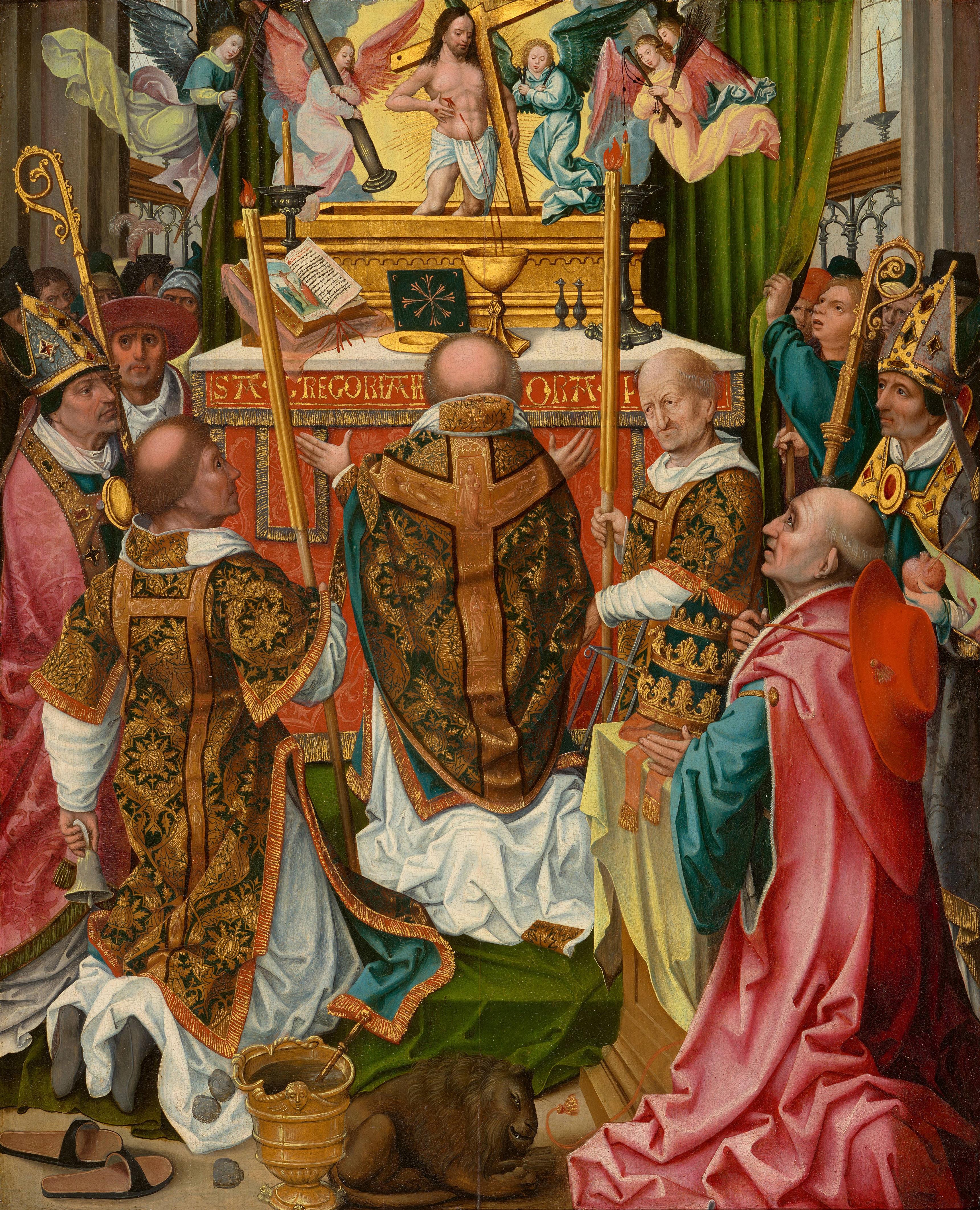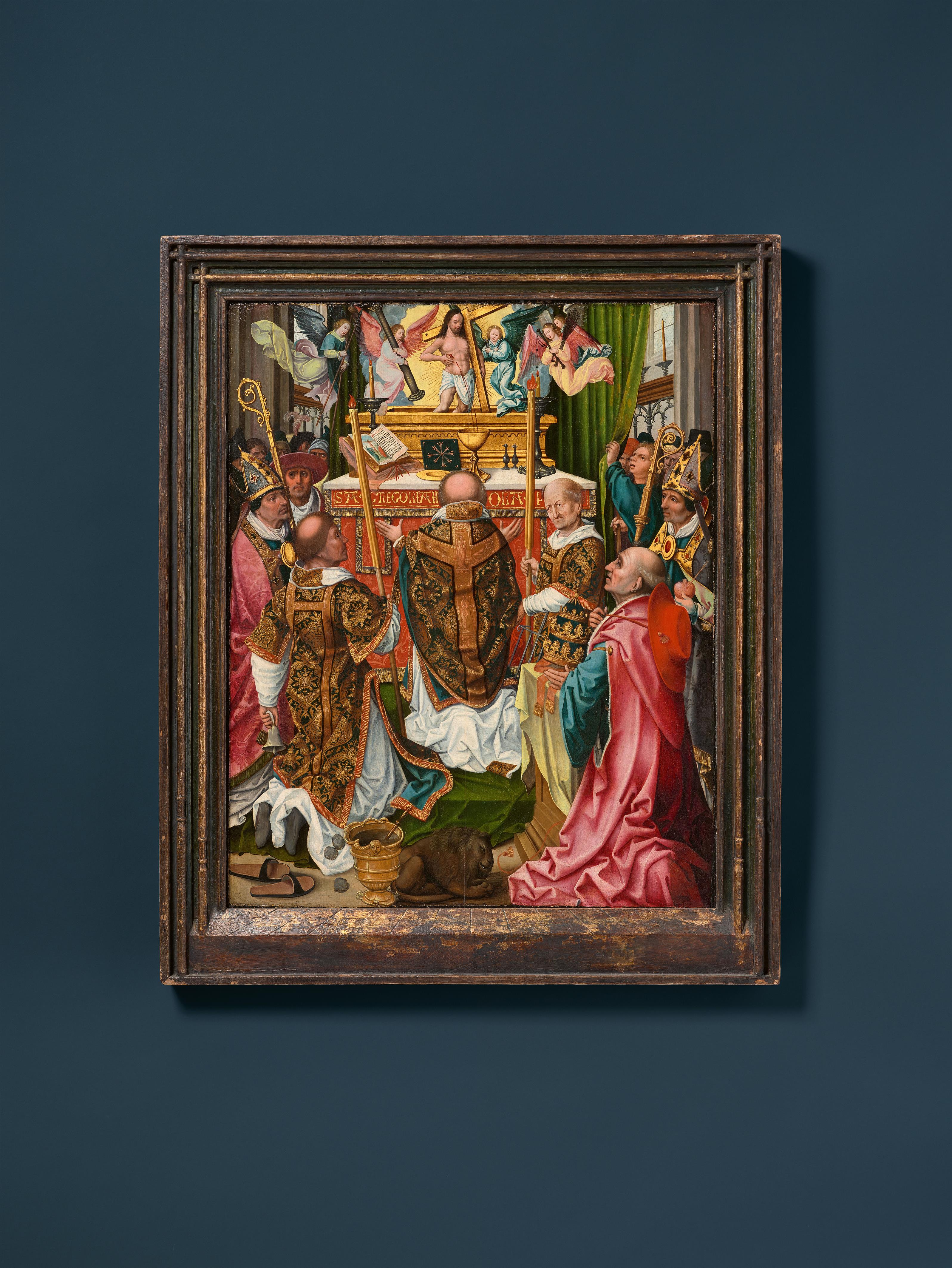Südniederländischer Meister (Brüssel?) around 1500
The Mass of Saint Gregory
Oil on panel (parquetted). 79 x 61.5 cm.
The proceeds from this lot and Lempertz´s commission will be donated to humanitarian aid in the Ukraine.
This densely populated and colourful depiction of one of the most fascinating religious themes of the late Middle Ages shows the miracle of the Mass of Pope Gregory the Great. The Pope is depicted in front of an altar, having placed his tiara aside on a low cabinet covered by a yellow cloth. He kneels before the altar with his arms outstretched in adoration of Jesus, who appears before him bodily in the form of the Man of Sorrows, rising from a coffin with the Cross. The figure of Christ is framed by five angels bearing the Arma Christi - the symbols of the Passion - lance, sponge, column, nails, scourge and rod. Jesus, clothed only in the loincloth and without the Crown of Thorns, holds the Cross with His left hand, and with His right hand, fingers spread, grasps the wound in His side from which blood gushes into the chalice on the altar.
Reason for the apparition was the doubt of one of those present at the mass about the transformation of the bread and wine into the body and blood of Christ during the sacrament. Pope Gregory asked for a sign, whereupon the Man of Sorrows appeared at the altar and proved the miracle of transfiguration. Christ appears almost nude, half-length, in a form showing multiple references to the Passion. Through His presence and the blood flowing into the chalice, Christ demonstrates the literal transformation of the bread and wine into His body and blood during the Mass. In reference to the Mass, we see a paten and chalice, palla and vials of water and wine on the altar. At the same time, the Man of Sorrows rising from the open coffin refers to the resurrection of Christ, and thus to the redemption of mankind through Christ's suffering. This scene is also depicted in the canon table of the missal lying on a lectern to the left of the altar. The intercession of Pope Gregory is requested in the text "SA(NCTVS) GREGORIAN(VS) ORA P(RO NOBIS)" ("St. Gregory, pray for us") on the fabric antependium.
Pope Gregory, one of the four Fathers of the Church, is here accompanied by the other three: in the right front we see St. Jerome as a cardinal with his attribute, the lion, in the foreground in the centre. On the right behind Jerome, holding a heart pierced by an arrow as an attribute, is St. Augustine, Bishop of Hippo. On the left edge of the picture stands St. Ambrose, Bishop of Milan and another holy cardinal. The Pope, clothed in a precious brocade chasuble with embroidered borders showing Christ and the Apostles, is assisted by two Holy Deacons as acolytes, St. Lawrence with his attribute, the griddle, on the right and St. Stephen, recognizable by the three stones at his feet. Both wear dalmatics of the same brocade fabric as the pope's chasuble. In the hallway in the foreground we see a bucket of holy water with an aspergillum decorated with early Renaissance ornament.
The chancel is enclosed by choir screens and in front of it hangs a green velvet curtain, which is pushed aside to the right by a believer, so that he and the faithful behind him can enter the altar room and see with their own eyes the miracle of the transformation. The image of the Mass of Saint Gregory was traditionally associated with great indulgences for all those who repented of their sins and knelt down to pray before the Man of Sorrows. This is also referred to in the text on the antependium, which identifies Pope Gregory as the mediator. The motif came under heavy criticism in connection to the widespread use of indulgences in the early 16th century, so that the popular depiction of Pope Gregory's mass also disappeared with the spread of the Reformation.
This well-preserved panel has received little attention from researchers until today. Offered at auction by Lempertz in 1940, it disappeared into obscurity for many years until 2004, when it was shown at the Saxon State Exhibition (cf. literature). The artistic origin of the panel has not been securely clarified to this day. The sumptuous panel with its splendid colours, rich brocade vestments and precious gold leaf used for the coffin and the liturgical utensils is reminiscent of the splendour demonstrated in some works of the Cologne Master of the Saint Bartholomew Altar. However, it appears to have been created in a different artistic environment. In 1999, Edwin Buysen (in a letter dated 1.11.1999 to the LVR-Landesmuseum Bonn) connected it with a large-format painting in Bonn depicting Pentecost, dated 1519, which is considered to be the work of a South Netherlandish Master (cat. Gemälde bis 1900, Rheinisches Landesmuseum Bonn 1982, pp. 508-509). There is a kinship to this painting in the structure and arrangement of the figures in the foreground, as well as in the way in which the foreground is enlivened by large-scale objects.
In 2004 Gregor J. M. Weber argued for an origin in the circle of the Brussels-based painter Bernaert van Orley, referring mainly to the figures of Christ and the angels. However, the references to van Orley are only found among his early works, before the freer currents of the early Renaissance began to influence him. The compact, closed arrangement of the figures points to a creation shortly after 1500, more likely around 1510. In 1940, the panel was classified as Rhenish, and many aspects do indeed speak for this. However, the colour palette and the fluid painting style point rather to an origin in the Southern Netherlands, probably Brussels, shortly after 1500.
We would like to thank Dr Guido de Werd for this catalogue entry.
Provenance
Lempertz auction 408, Cologne, 26.-27.4.1940, lot 129. - DELI-collection, Monaco.
Literature
Exhib. cat.: Glaube und Macht. Sachsen im Europa der Reformationszeit. 2. Sächsische Landesausstellung Torgau, Schloss Hartenfels 2004, ed. by Harald Marx and Eckhard Kluth, Dresden 2004, p. 41-42, cat. no. 5.
Exhibitions
Torgau, Schloss Hartenfels 2004.




